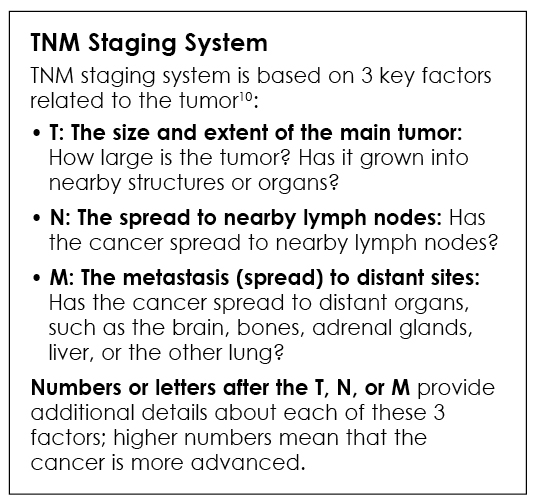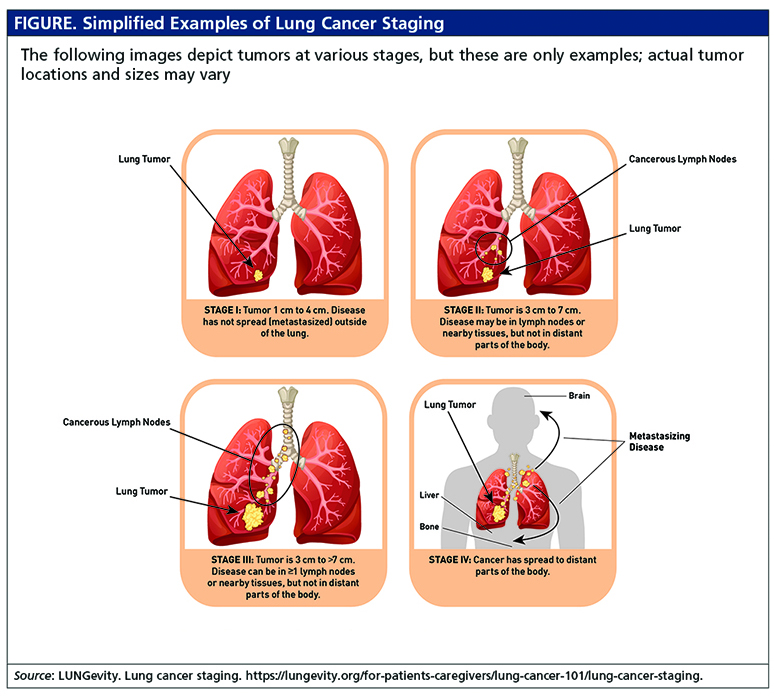TLG1784-1
Non–small-cell lung cancer (often referred to as NSCLC) is the most common form of lung cancer, accounting for about 85% of all lung cancer cases.1 Given the complexity of cancer, the rapid development of new treatments, and the large amount of information available, it may be challenging for patients to find materials that can help them to understand their disease better.
The goal of this 4-part series of articles is to present brief overviews of concepts that may be important to caregivers and patients with non–small-cell lung cancer, including tumor staging, treatment, biomarker testing, and the patient journey.
Here, we present how and why cancer staging is important, and provide a list of questions for patients to ask their doctors.
What Is Lung Cancer?
Lung cancer begins when healthy cells in the lung change and grow out of control, forming a mass called a “tumor,” a “lesion,” or a “nodule.” As they grow, lung cancer can begin to interfere with the functioning of the lungs, which have the role of providing oxygen to the body via the blood.2
The 2 major types of lung cancer are (1) non–small-cell lung cancer and (2) small-cell lung cancer.3 These cancers develop from different types of cells, and then grow and spread (metastasize) in different ways.4 Non–small-cell lung cancer is the more common of the 2 types of lung cancer, and accounts for about 85% of all lung cancers1 (see Box3,5,6).
Small-cell lung cancer accounts for the remaining 15% of lung cancers in the United States, and is most often diagnosed in people with a history of smoking.1,3,7 It is called small-cell lung cancer, because the cancer cells appear small (and are oval-shaped) when looked at under a microscope.8 This type of cancer tends to grow and spread faster than non–small-cell lung cancer.8
As a malignant tumor grows in the lung, it may shed cancer cells. These cancer cells can be transported in the blood or in the fluid called lymph that surrounds lung tissue.5 These cancerous shed cells are important, because they can move to other parts of the body and form new tumors, a process called metastasis.
What Is Cancer Staging, and Why Is It Needed?
In cancer, staging is the process of finding out how much cancer is in a person’s body, and where it is located. Cancer staging is then used to plan the best treatment for the patient, and when appropriate, to identify any clinical trials that could be an option for the patient.9,10
For most types of cancer, doctors use staging information to plan the most appropriate treatment for patients and to predict a person’s outlook (called “prognosis”). Although each patient’s situation is different, cancers with the same stage tend to have comparable outlooks and may often be treated in a similar way.
How Is a Cancer Stage Determined?
To learn the stage of the disease, the patient’s doctor may order imaging, laboratory tests, and other tests or procedures.9,10 Non–small-cell lung cancer is typically given a clinical stage based on the results of a physical exam, biopsy, and imaging tests.10 If surgery is done, doctors can determine the pathologic stage (also called the surgical stage) by directly examining tissue removed during the operation.
To determine the tumor’s stage, doctors will assess the size of the tumor, whether it has spread to nearby lymph nodes, and whether it has metastasized to other sites, calculated using the TNM (Tumor, Nodes, Metastasis) staging system (see Box).
Specific combinations of the TNM system are then used to determine the cancer’s stage from 0 to IV, with lower stages being the least advanced. The following is a general overview of staging in non–small-cell lung cancer. Note that stages may also have subcategories that are not listed here.
Stage 0: Disease at this stage is called “in situ,” meaning that the cancer is “in place” and has not spread from where it first started.11
Stage I: The cancer is located only in 1 lung, has not spread to any lymph nodes, and has not metastasized. Stage I tumors are smaller than 4 centimeters in the longest dimension.3
Stage II: The cancer is in the lung, where it started, and in nearby lymph nodes, but it has not metastasized to distant parts of the body. Stage II tumors can measure up to 5 centimeters in their longest dimension. In addition, they might have grown into nearby sites (for example, the chest wall, nerves passing between the heart and lung, or the heart’s lining) and might have caused lung collapse or swelling.11
Stage III: The cancer has spread within the chest but has not metastasized to distant parts of the body. These tumors are often described as locally advanced lung cancer. Stage III tumors can be longer than 7 centimeters in their greatest dimension and might have spread to lymph nodes in the center of the chest. At stage III, multiple tumors may be present within the same lung. Stage III tumors might have grown into other tissues within the chest, such as the diaphragm, heart, windpipe, or the esophagus. As in stage II tumors, stage III tumors might have caused lung collapse or swelling.11
Stage IV: This is the most advanced stage of lung cancer and may also be described as advanced disease. In stage IV lung cancer, the cancer has spread from one lung into the other, into the fluid in the area around the lungs, or to another part of the body, such as the liver or other organs.11
To learn more about non–small-cell lung cancer staging, visit https://www.cancer.org/cancer/lung-cancer/detection-diagnosis-staging/staging-nsclc.html.12
Remember that the stage of a cancer can be determined only during (or soon after) the cancer is diagnosed. After the stage is determined, it cannot subsequently be staged lower (excluding errors in the initial staging), even if the cancer shrinks; however, growth, spread, or recurrence of the cancer after treatment can cause the stage to be higher.
What Questions Can Patients Ask Their Doctor?
- What tests will be done to determine the stage of the cancer?
- What is the stage of the cancer? What does this mean?
- Can you explain my TNM staging to me?
- Has the cancer spread to my lymph nodes or to any other parts of my body?
- Based on the cancer’s stage, what are my treatment options?
- Are there clinical trials available for patients with this stage of cancer?
Be sure to talk with your doctor and ask questions when things are not clear, so you have the information about the stage of your cancer, which will help you and your caregiver or family members to make sure you understand the best treatment options available for you.
References
- Dela Cruz CS, Tanoue LT, Matthay RA. Lung cancer: epidemiology, etiology, and prevention. Clinics in Chest Medicine. 2011;32(4):605-644.
- CancerCare. What is lung cancer? https://www.lungcancer.org/find_information/publications/163-lung_cancer_101/265-what_is_lung_cancer. Accessed January 22, 2020.
- CancerCare. Types and staging of lung cancer. www.lungcancer.org/find_information/publications/163-lung_cancer_101/268-types_and_staging. Accessed January 22, 2020.
- National Cancer Institute. Non–small cell lung cancer treatment (PDQ)–patient version. Updated October 16, 2019. www.cancer.gov/types/lung/patient/non-small-cell-lung-treatment-pdq. Accessed January 22, 2020.
- American Society of Clinical Oncology. Lung cancer - non-small cell: introduction. January 2019. www.cancer.net/cancer-types/lung-cancer-non-small-cell/introduction. Accessed January 22, 2020.
- Riess J. Shifting paradigms in non-small cell lung cancer: an evolving therapeutic landscape. American Journal of Managed Care. 2013;19(19 suppl):S390-S397.
- LUNGevity. Small cell lung cancer. Updated June 7, 2019. https://lungevity.org/for-patients-caregivers/lung-cancer-101/types-of-lung-cancer/small-cell-lung-cancer. Accessed January 22, 2020.
- National Cancer Institute. Definition: small cell lung cancer. www.cancer.gov/Common/PopUps/popDefinition.aspx?id=45327&version=patient&language=English&dictionary=Cancer.gov. Accessed January 22, 2020.
- National Cancer Institute. Cancer staging. March 9, 2015. www.cancer.gov/about-cancer/diagnosis-staging/staging. Accessed January 22, 2020.
- Liam CK, Andarini S, Lee P, et al. Lung cancer staging now and in the future. Respirology. 2015;20(4):526-534.
- LUNGevity. Lung cancer staging. Updated January 3, 2019. https://lungevity.org/for-patients-caregivers/lung-cancer-101/lung-cancer-staging. Accessed January 22, 2020.
- American Cancer Society. Non-small cell lung cancer stages. Revised October 1, 2019. www.cancer.org/cancer/lung-cancer/detection-diagnosis-staging/stagingnsclc.html. Accessed January 22, 2020.
Articles in this Series
- Staging of Non–Small-Cell Lung Cancer: A Guide for Patients
- Treatment of Non–Small-Cell Lung Cancer: A Guide for Patients
- Biomarker Testing in Non–Small-Cell Lung Cancer: A Guide for Patients
- The Patient Journey in Non–Small-Cell Lung Cancer: An Overview



















